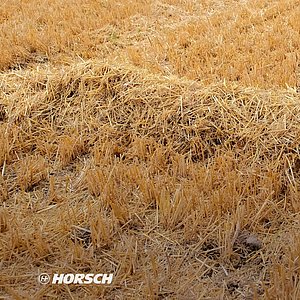Straw distribution before and after stubble cultivation (I)
Average reading time: 3 minutes
Straw – it is a by-product of the harvest, but its significance of straw and, thus, also for straw management is constantly increasing.
But why is straw distribution important?
The basis for the following crop is already laid by what remains behind the combine. Successful rotting guarantees even emergence and a minimised disease pressure. To achieve this, an optimum straw distribution and an excellent chaffing quality are essential parameters.
Some people might wonder: Remove the straw or incorporate it?
Leaving the straw on the field - the advantages
- Good nutrition base for soil biota (especially for earthworms) and microorganisms
- Building up of humus is encouraged
- Soil fertility and soil structure are improved
- Aggregate stability increases
- Risk of erosion is reduced by the mulch layer
How to handle the straw?
It is important to keep the straw issue in mind already when threshing – starting with an even transport of the goods at the cutting unit to an optimum adjustment at the straw chaff cutter. All these factors play a decisive role with regard to a successful straw management. It is recommended to distribute the straw slightly asymmetrically backwards. Thus, it is not thrown into the population and overlapping is avoided.
With regard to straw distribution, influencing factors like crosswind and humidity aggravate the conditions for practical use. To assess the straw distribution and to readjust the combine accordingly, we recommend taking a look at what happens behind the combine.
Check the straw distribution
We recommend raking up a two-meter-wide strip of straw over the whole cutting unit width in the direction of travel and assessing it visually. If the height of the swath is almost the same over the whole length, a good straw distribution is guaranteed.
A look at the straw
Yes, it pays off. For the straw should provide as much contact area as possible for microorganisms to encourage fast rotting. Therefore, frayed, short stubbles are considered to be ideal. An average of approx. 3 cm is a reference value for the chaffing length. This length is considerably influenced by the quality of the chaffing knives. The following crop also benefits from a quick degradation of harvest residues. For the disease pressure and, thus, an infestation in the following year by the germs that are located at the straw, e.g. fusarium in wheat or sclerotinia in rape, are reduced.
After the combine – stubble cultivation
A pass that should not be underestimated and that pursues several objectives:
- Distribute the straw more evenly
- Encourage the germination of volunteer seed, produce and consolidate fine earth
- Tear out resp. cut off weeds that are still standing
- Break open the soil and break capillarity
Patent remedy for straw distribution after stubble cultivation?
There is no patent remedy for the following stubble cultivation. It depends on many factors and objectives and has to be customised.
In general, the following pass has to be adapted to the prevailing conditions. The straw distribution is crucial for the cultivation direction. The determination of the track depth and the soil profile by means of a spade test allows for drawing conclusions about the required cultivation depth and the tools that should be used.
Another principle that is responsible for a successful stubble cultivation is the homogeneous incorporation of the straw remains. This is to prevent the creation of concentrated straw nests on the surface or in horizons. For in these spots an optimum rotting cannot take place and the even emergence of the following crop is impeded.
The principle to create as much straw-earth-contact as possible should not be neglected. For it sees to it that a quick and successful degradation by the microorganisms can take place.
Both criteria, a good mixing and the homogeneous incorporation, are influenced by the time the organic matter stays in the machine. Thus, the influence of the transport distance of the straw is quite considerable. And exactly this parameter is to be determined and assessed for different machines and systems by means of a test.
You can find the results in part two (Straw distribution after stubble cultivation II) of our blog series on stubble cultivation.
Straw management at a glance
It pays off to intensely deal with the straw topic. For straw is an important nutrition base for microorganisms and improves the soil structure. If you pay attention to the essential points, straw management can be successful:
- Optimum straw distribution
- Good chaffing quality
- Site-specific stubble cultivation
- Good mixing
- Homogeneous incorporation


